Edwardian walking dresses: What Edwardian women wore in cold and rainy winter weather and for summer hiking vacations.
‘The very best form of exercise, all doctors agree, is walking. It brings into action every muscle of the body, stimulates the organs and circulation, and provides an interesting amusement, because it is enjoyable. It induces health because it does not overstrain any part of the body, and it brings beauty of form because it gets rid of superfluous tissue, and, at the same time, develops the muscles, thus filling out the hollows and thin places.’ (Every Woman’s Encyclopaedia, 1910-2a)
Edwardians were fond of walking. Even rain didn’t stop them: They believed a walk through rain was an excellent skin toner! But the clothing had to be light and warm so as not to catch cold. Edwardian walking dresses usually consisted of a short leather-lined wool skirt, a wool jacket or sweater, walking boots and a soft felt cap or hat.
Edwardian Walking Dresses
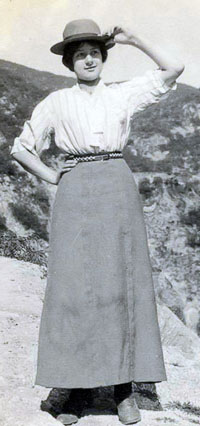
‘The matter of clothing largely depends on the season. […] But even if the tour is to be in midwinter, no heavy overcoats or dragging undergarments should be worn. Light woollen underclothes are the safest and healthiest, cotton garments are likely to be extremely dangerous. If a woman is used to corsets, some pliable hygienic make without bones, or those made of ribbon, are the only possible wear.
Dark serge or stockinette knickers should be worn under a short, plain tweed skirt. The kind of jersey made like a man’s football “sweater,” pulling on over the head, is the neatest and most comfortable form of coat. It resists rain for a long time, protects the chest and back from sharp winds, can be dried quickly, and, if necessary, washed.
A small woollen cap, known as a “rinking cap,” which only needs two hairpins to keep it in place, is extremely becoming, and suitable either for summer or winter. The only alteration necessary for this outfit in summer would be that the jersey would be carried in the “kitbag” to be ready for cold or rainy days. Even on the hottest days, a flannel blouse, with a low collar, is preferable to a cotton one, but if the hat affords no protection for the neck from the midday sun it is very unwise to leave the back of the neck bare, and an upright flannel or soft linen collar should be worn.
Boots and stockings are most important factors in the pleasure and comfort of a walking tour – new boots are, of course, impossible, and those freshly soled are not to be recommended. A light, high boot with a broad welt and a flat heel is always comfortable and safe even in the worst weather. By far the best kind of stockings to wear are thick cashmere ones, for all people who have walked a great deal agree that thick stockings, even in summer, are quite the most comfortable. They enable the boots to fit more perfectly and so prevent chafing, which quickly makes walking impossible.’ (Every Woman’s Encyclopaedia, 1910-2a)
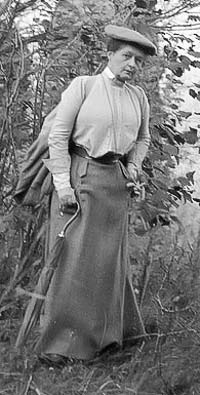
‘An invaluable possession for the holidays […] is the serge or tweed dress made with a short skirt; and all short skirts should be lined flatly having no separate foundation and fastening down the side of the front; thus only do they make for comfort and lightness of weight.’ (The Delineator, 1902)
‘The short skirted girl of a couple of seasons past was the freak; she was the Rainy Daisy, the pedestrian girl, the mountain girl, the climbing girl. She was everything but the pretty girl. For the short skirts, as they were made then, were not pretty. […] But now it is different: The swing-clear skirt no more resembles the short skirt of a few years ago […] The skirts of this season, those that are made on the new art lines, all swing clear.’ (San Francisco Call, June 1904)
‘For wear under this escape-the-ground skirt there comes a little brilliantine petticoat which is only a little longer than the knees. It is not full and its only trimming is a contrasting band of taffeta around the bottom. This petticoat looks odd to the woman who has never worn it, but it is so very comfortable and so well suited to its purpose, which is that of making the pedestrian skirt hang well, that one forgets its looks.’ (San Francisco Call, 1903)
‘The best outing hats are the ones that can be wet with rain, dampened with sleet, coated with road dust and stained with vagrant spots without revealing their vicissitudes to the beholder.’ An English outing hat, which Queen Alexandra wears for a walk in the Scottish hills or ‘when she goes out to feed her dogs […] is a ready-to-wear hat of felt, slightly mixed in gray and black, rough to the touch and trimmed with a band of gray tweed and a quill of black.’ (San Francisco Call, June 1903)
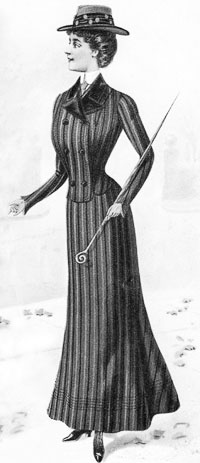
‘There are few women who can wear a really truly “walking hat” and look their best in it. […] The real walking hat is the most trying thing a woman can put on her head. It is stiff, scantily trimmed, if trimmed at all, and has the unhappy knack of bringing out one’s bad points […]
Other hats can be twisted and turned and made to be becoming, but not this hat. Its brim […] unbendable […] it “stays put” […] So the woman is made for the hat and not the hat for the woman. She whose face can stand this severeness of outline is usually of the severe type or just the opposite with fly-away hair and tiny features […]
The walking hats in the rough straw are by far the most stylish. […] Some are made of cloth, with rows and rows of stitching, and trimmed with soft silk crepe and white wings. The straw hats are trimmed with the ribbon. Some of them that are like soldiers hats have a crushed band of the ribbon around the crown and a large double bow tacked securely to the crown a little to the left. […] A very natty hat is on the Alpine order with rolling brim and sets well over the face. […]
Do remember that walking hats are to be worn only with cotton shirt waists and tailor gowns, and are totally out of place with anything else’, such as silk gowns and lace blouses. (San Francisco Call, 1900)
Edwardian Walking Dress For A Walk In The Rain
‘Every now and then there will be such shocking weather that a knee-length skirt and rubber boots would be the most appropriate garb.’ (Los Angeles Herald, 1909)
‘Laurels belong to the woman who manages to look spruce and jaunty on a rainy day. […] Is there anything more cheering on those gloomy days when life looks colorless and dim, than the sight of a dainty maid, undaunted by the lowering heavens and the slushy earth, tripping lightly over mud and grime, and beaming rosily beneath her dripping umbrella? […]
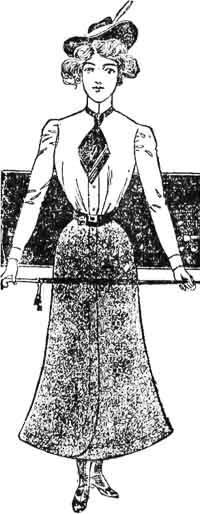
The rainy day girl has entirely discarded rubber coats and mackintoshes. […] She wears now one of the new patent reversible skirts of Scotch plaid with a little double-breasted jacket […] Her skirt reaches to the top of her boots and is waterproof; just heavy enough to keep the slightest moisture from permeating, and yet light enough to give her free and unhampered action.
The new reversible skirst are made without plackets, and are so large in the waist that they slip easily over the head. […] The skirt is plain on one side and plaid on the other, and so neatly made that it is simply a matter of taste and choice with the wearer as to which side shall be worn in or out. […] With stout pigskin cork-soled boots she may venture without galoshes’ (Los Angeles Herald, 1900).
‘Walking in the rain, for persons who are not susceptible to cold, is an excellent tonic for the complexion, but one that must be prepared for in order to get the most benefit.
For instance, when taking such a tramp the clothing must be warm, the skirts of a length not to drag the wetness about the ankles, for nothing will give cold more quickly than the constant slopping of wet garments about the feet.
The ideal walking costume for wet weather consists of a thick and warm, but not heavy, short skirt. The length need not be so abbreviated as to be conspicuous in city streets, and a blouse of thin French flannel and a short jacket are best for the upper portion of the body. A jacket is far better for walking than a long coat, as the latter is apt to drag or pull when the wearer is exercising, and a short garment gives freedom of movement.
A soft felt hat of a color to match the suit should be trimmed with one or more wings and a band of soft silk. Water, unless floods descend, will not hurt it, and thus the carrying of an umbrella is obviated.
No boots are as serviceable as those that are a trifle higher than regulation. These walking boots come about half way to the knee, are thick soled, lace, and will protect ankles and calves from dampness. It is an unfortunate fact that any skirt longer than knee length becomes damp about the bottom, as it is rubbed by the heels during walking. Bloomers of silk are to be preferred to petticoats for this particular costume.
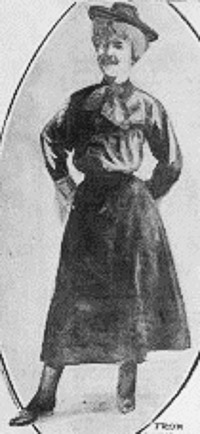
Clad in such fashion the risk of dampness or chill penetrating to the skin is almost impossible. One may be in a drenching rain and come forth unscathed, for should the jacket be wet through the shoulders the latter are still protected by the flannel blouse.
But to derive benefit it is essential that the exercise shall be rapid. Just then minutes’ brisk walking in a steady downpour will make the blood circulate with vigor and put the pedestrian into a delightful glow. However, it is absolutely imperative to keep moving rapidly as long as one is out of doors, and the length of time one walks in the rain must be regulated by individual strength, as well as by inclination.
One who has not been accustomed to walking is apt to be tired in fifteen minutes, and care should be taken not to get so far away from home as to delay in returning. To become overtired is too often the means of contracting cold, nor must it be thought that to go home in motor or trolley will be healthy. Constant motion of the muscles is the only thing that will prevent cold.
On going into the house damp garments must be removed immediately, and if there is the least suspicion of moisture on the feet stockings as well as shoes should be changed. Different petticoats and, of course, another dress must be donned.
I wish girls who have not tried this rainy-day treatment would give it a fair test, for I am sure they would enjoy it and would be benefited, if only they would take the precaution not to contract cold.’ (Health And Beauty Hints, 1910, p. 98f.)
‘If you are so unfortunate as to get your gown mud-stained be sure to wait until it is entirely dry and then brush off with a whiskbroom and sponge the marks until they disappear. If the cloth is spotted with rain, iron on the wrong side with a piece of old muslin between the cloth and the iron.’ (The Minneapolis Journal, 1906)
Edwardian Winter Walking Suit
‘The materials of which winter clothes are made should be light as well as warm, as heavy clothing impedes the circulation. All wool materials are the lightest, and wear the best;
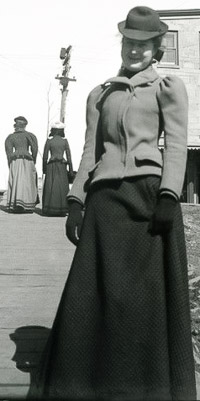
they keep their colour, and do not look shabby so soon as those made of a mixture of wool and cotton.
Serges and tweeds should be employed for coats and skirts for hard wear. A good Harris tweed, tailor-made, is practically everlasting, and for the country and hard wear is excellent. […]
The tweed or frieze cloth coat which is required for really cold weather should always be lined, either with silk, satin, or sateen. However thick the frieze or tweed may be, the wind has power to pierce through it, but the lining will prevent its reaching the wearer. Many of these coats are made so that they can be worn either open or closed over the chest, and with a turned-down or stand-up collar. […] Long fur coats and fur-lined cloaks should not be worn for walking; their weight makes them quite unsuitable […]
Narrow skirts are not adapted to the sportswoman, but, if worn, additional width and freedom can be obtained by the addition of pleats each side of the skirt, which allow full play to the limbs, and yet preserve the smart appearance. […]
Ribbons as [hat] trimmings are very suitable for bad weather […] For cold weather the wearing of lined leather gloves is not advisable. A pair of woollen gloves worn over kid ones are much warmer and better in every way, and they can be easily removed if the hands get too hot. Those who suffer from cold hands should see that their gloves are long enough to cover the wrists, as it is most important to keep them warm. Gloves should never be tight; nothing makes the hands cold more quickly. […]
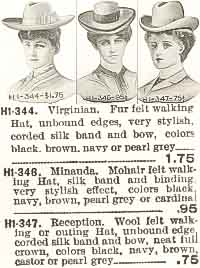
For windy weather all the garments should be as close-fitting as possible. […]
For serviceable skirts it is not a bad plan to have the hem lined up inside with leather about four inches deep. It helps to weight the skirt and keep it down, and in wet weather if the hem gets muddy it can be easily sponged and dried.
Boots are the best wear for winter; if shoes are worn, gaiters should be added for the sake of warmth and dryness. Raincoats of waterproofed cloth are preferred to mackintoshes by many; they are healthier in wear and have no smell, and will resist any ordinary rain.
For winter wear all-wool undergarments are decidedly the best. However thin, if they are of pure wool they are a great safeguard against chills. But some skins are too sensitive for woollen underwear; for these a mixture of silk and wool is more comfortable and almost as warm. Divided skirt knickers of a really warm, light material will be found a very comfortable substitute for the usual petticoat for everyday wear with short dresses […] Stockings should be of wool or silk.’ (Every Woman’s Encyclopaedia, 1910-2b)
Edwardian Shooting Outfit
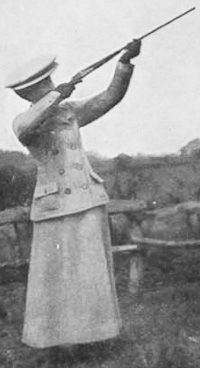
‘Silk petticoats and outer skirts are cut sufficiently short so as not to interfere in any way with one’s progress, and the progress of the party. A woman may be a splendid shot and a good companion, but if her skirts are such that they are forever catching on something and necessitating the services of a masculine member of the party to disengage her from a branch or rock she will soon be looked upon as an intruder. […]
Leather is perhaps the most serviceable material that could be chosen for the hunting suit. It is impervious to cold and dampness, and though it may scratch it does not tear. […] Ooze calf with its soft, velvety surface is particularly attractive in a coat suit trimmed with shiny brown kid. The short skirt coming just to the tops of the high waterproof cowhide hunting boots is a prettily flared gored model banded at the bottom with the kid stitched flat over the calf. […] A gray sweater rolling high around the neck is worn with this suit instead of any kind of a separate blouse, and a brown woolen tam o’shanter and brown gauntlets’ (Los Angeles Herald, 1908).
‘A shooting skirt should be unlined, and made with a boxpleat at the back, to allow of room for fence climbing. It may be lined up with leather for a few inches, or faced with its own material – this latter plan is perhaps the best – and worn over stockingette knickerbockers.
A small felt or tweed hat or cap of the same invisible colour as the coat and skirt should be worn, leather gloves, and high blacking leather boots, with nails in them, reaching to the knee. As a substitute, stout shoes and high cloth gaiters may be worn.
The most useful coat is of such a length that the wearer can sit upon the back of it, and a breadth of mackintosh may with advantage be fastened across the lower part of the back of the coat, enabling the wearer to sit on damp grass with impunity.
The coat collar should be so arranged that it can be turned up and fastened tightly round the throat in wet weather.
The pockets should be lined with mackintosh, and completed with outside flaps to button down, so that cartridges, kodak films, or luncheon sandwiches can be kept clean and dry.
Under the coat a silk or flannel shirt, with soft collar and tie of any suitable colour, may be worn.’ (Every Woman’s Encyclopaedia, 1910-2a)
Colors & Materials Of Edwardian Walking Dresses

‘Warm browns and various shades of red are, of course, particularly adapted to winter wear, but there are many whom these colours do not suit. They should choose instead warm shades of different colours – dark blue, inclining to purple rather than indigo; greys, with a tone of heliotrope in them; or mole colour, which inclines to pink or brown rather than green. Colour has a much greater effect on our feelings than we always realise, and in cold, cheerless weather to wear cold shades of colour is to affect everyone with a disagreeable sensation of chilliness. […]
Sometimes a cold-coloured costume can be made to look warm and suitable for winter by the judicious admixture of warm colours in the trimming; a waistcoat or blouse of some brilliant tint can be worn with it, or a touch of warm colour in the hat. Many charming combinations can be obtained in this way.’ (Every Woman’s Encyclopaedia, 1910-2b)
‘The best kit for shooting consists of a light tweed coat and skirt – waterproof, it possible, and chosen in a shade which will render its wearer as invisible as may be. A light brownish green, somewhat the colour of a lichen-covered stone, is excellent; or a heather mixture with a good deal of purple in it is good for grouse shooting or the moors; and a light russet brown, the colour of dead bracken, is both serviceable and becoming for pheasant shooting.’ (Every Woman’s Encyclopaedia, 1910-2a)
Edwardian Women & Hiking Vacations
‘One reason why country people are much healthier and longer-lived than townspeople is

that the walking which they of necessity must do benefits them more than the so-called
“restful” driving, without which the townspeople imagine they could not live. So few townspeople know the joy and pleasure of walking; they usually say it makes them tired, and a motor ride gets them to their destination so much more quickly. This unfavourable view of the only really natural exercise is held generally because they do not know how to walk.
As I am writing this article for women, I should like to emphasise the fact that a woman can walk – if she be strong and wear sensible clothing – as well as any man. The reason why so many women who live in towns cannot walk is because they either wear tight garments or ridiculously high-heeled shoes, or have developed the habit of always going everywhere in some conveyance.
Every woman can walk well if she chooses to train, and she can have the certain prospect of much improved health. There is no reason why, when walking holidays are suggested to women, they should say: “They’re only for men – women are not strong enough.”
Among both sexes walking holidays, until quite recently, had entirely gone out of favour –
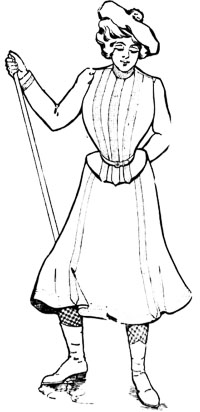
motoring or cycling was considered preferable. But now, when the true key of health is being strenuously searched for, walking, necessarily, must again become popular.
In general, the majority of people still think with fear of the idea of a walking tour. Many who have tried it have walked too far the first few days, thoroughly overtired themselves, and given it up as “an extremely injurious and uncomfortable kind of holiday.” Those who have not tried it raise objections about clothing, night accommodation, English climate, and so on. I hope to show that the first person’s idea is distinctly a false one, and that the second need have no fear about any such apparently worrying questions.
The first and most vital question before starting on a walking holiday is the choice of a companion or companions. Far better to go alone than to have a grumbler or one with utterly opposite tastes, spoiling every day as it comes. This matter needs very careful consideration, for on it largely depends the success of the walking tour. Two is the ideal number, and, of all twos, husband and wife the most perfect. Two girls or two men of similar tastes are the next best arrangement, and then, for those who like it, the party of half a dozen or more men and girls.’ (Every Woman’s Encyclopaedia, 1910-2a)
Outfit For A Hiking Vacation
‘Now as to clothes. It is plain that you should not set out upon a two-hundred-mile walk dressed in broadcloth, kid gloves, and patent leathers. Take your every-day suit, see that
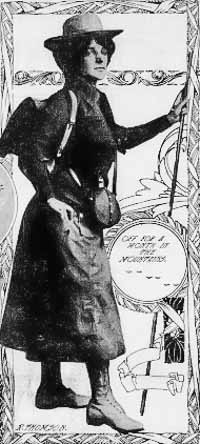
all the pockets are sound, and the buttons sewed on tightly.
Be sure that your shoes are thick-soled, well oiled and broken in; and, if you are going to climb mountains, tell the cobbler to put soft iron nails into the heels instead of hard iron or steel, for the latter become smooth and slippery, making your footing unreliable on steep ledges. There is no need of suggesting that you may paddle about barefooted now and then. […] Bathe your feet every night, and if they are a little tender put soap on your stockings.
You will see from my inventory that I carry no stockings except those that I wear. It is more convenient to wear out the pair you start with, washing them now and then, than to carry extra ones. When they are no longer serviceable, throw them away and buy new ones. […]
Wear a flannel shirt with gauze underclothing next to the skin. Let the shirt be one of those convenient arrangements with a rolling collar that you can turn down your neck on state occasions, placing over it a linen or paper collar, and a scarf. As the collar and tie conceal all traces of the shirt, nobody knows that you are not arrayed in the finest linen.
How do I get my shirt washed? In this way: my nightgown is arranged with collar buttons, and I conceal the front with the collar and scarf, wearing it in place of my shirt while the laundress is scrubbing the dust out of that garment. Flannel shirts need washing but seldom where underclothing is worn, a good shaking often sufficing to get the dust out of them. The night-gown, collar, handkerchief, and underclothing should be washed and ironed for you within eight hours, if you make the laundress understand that you can wait no longer for them.’ (The Book Of Athletics And Out-Of-Door Sports, 1895)
More About Edwardian Fashion
-
The Edwardian Sweater Girl + 25 Free Edwardian Sweater Patterns
-
Edwardian & WW1 Tam O’Shanter Hats – Free Knit & Crochet Patterns
-
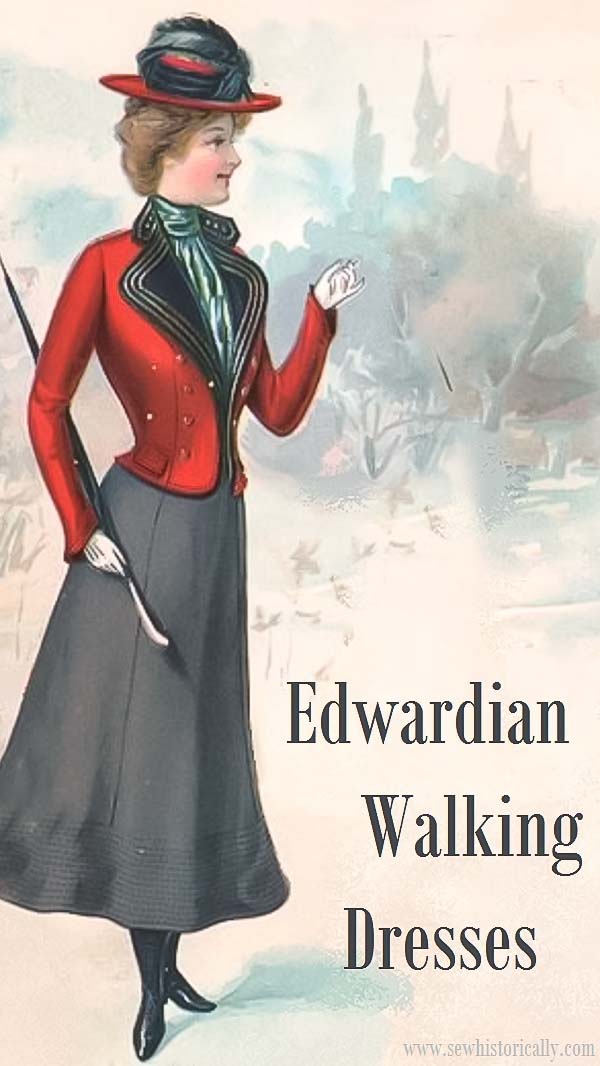
I had no idea that Edwardian walking dresses were once a thing. Fascinating!
Thanks for stopping by, Michelle! 😀
Such gorgeous outfits. I wish, in away, that these were still fashionable.
Thank you! Edwardian-style blouses and skirts are still fashionable today! 🙂